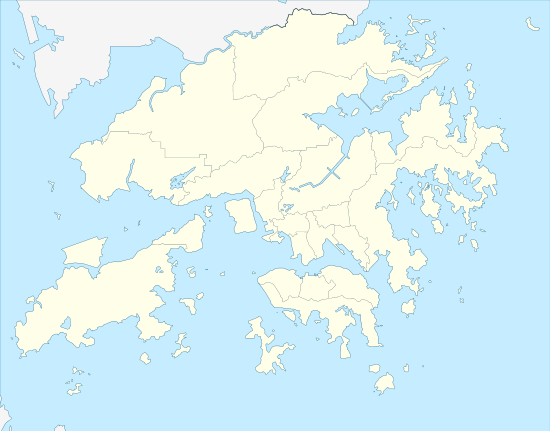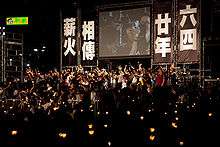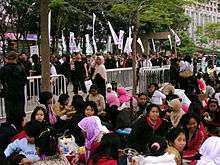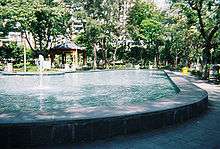Victoria Park, Hong Kong
| Victoria Park | |||||||||||||||||
|---|---|---|---|---|---|---|---|---|---|---|---|---|---|---|---|---|---|
| 維多利亞公園 | |||||||||||||||||
|
Victoria Park, Hong Kong | |||||||||||||||||
 | |||||||||||||||||
| Type | Urban park | ||||||||||||||||
| Location | Causeway Bay, Hong Kong Island | ||||||||||||||||
| Coordinates | 22°16′54.18″N 114°11′20.09″E / 22.2817167°N 114.1889139°ECoordinates: 22°16′54.18″N 114°11′20.09″E / 22.2817167°N 114.1889139°E | ||||||||||||||||
| Area | 19 hectares (47 acres) | ||||||||||||||||
| Opened | October 1957 | ||||||||||||||||
| Managed by | Leisure and Cultural Services Department | ||||||||||||||||
| Status | Open all year | ||||||||||||||||
| Website |
www | ||||||||||||||||
| Chinese name | |||||||||||||||||
| Traditional Chinese | 維多利亞公園 | ||||||||||||||||
| |||||||||||||||||

Victoria Park (Chinese: 維多利亞公園) is a public park in Hong Kong, named after Queen Victoria of the United Kingdom. It is located in Causeway Bay, on the north of Hong Kong Island, between Causeway Bay and Tin Hau MTR stations. It is part of Wan Chai District, bordered by Victoria Park Road and then Victoria Harbour to the north and Causeway Road and Hong Kong Central Library to the south. The park underwent a major revamp in the early 2000s, which gave it many of its new features, including the basketball courts and tennis stadiums.
History
The park was formerly a typhoon shelter known as Causeway Bay Typhoon Shelter, part of Victoria Harbour, used as a refuge by fishing boats and yachts during typhoon seasons. In the 1950s, the shelter was reclaimed and the park was built there. The typhoon shelter was then relocated to the north.[1][2]
The park has long been a gathering place for domestic workers on Sundays, their usual day off. Since the early 2000s, helpers from Indonesia have come to predominate, in and around the western end of the Park, as their numbers in Hong Kong have increased relative to those from the Philippines. The parallel tradition for Filipina domestic workers is to congregate around Statue Square in Central.[1]
A portion of the park is presently occupied by construction of a slip road for the Central–Wan Chai Bypass project. This has been "hugely controversial" as local councillors and residents alleged they were not informed that the road would cut through the park.[3] In March 2015 construction unearthed unexploded ordnance dating from World War II and the Explosive Ordnance Disposal Bureau of the Hong Kong Police Force was called in to dispose of it.[3]
Features
There is a statue of Queen Victoria, seated, at the main entrance of the park on Causeway Road. This statue was cast in Pimlico, London and was originally located in Statue Square. During the Japanese occupation of Hong Kong, it was taken to Japan to be melted down, along with other statues from the square. After the war the statues were brought back to Hong Kong, and in 1952 Queen Victoria's statue was restored and placed in Victoria Park. In 1996, shortly before Hong Kong's reunification with China, artist Pun Sing-Lui tipped red paint over the statue and smashed its nose with a hammer.[4] Pun was a recent immigrant from Mainland Chinese who had become discontented with Hong Kong culture.[5] Striking the statue and covering it in red paint was intended to serve as a protest against "dull colonial culture" and to encourage "cultural reunification with 'red' China".[5][6] His actions were decried as meaningless vandalism "in discord with popular opinions and the concurrent cultural atmosphere" and an "attack on Hong Kong culture".[5] The statue was subsequently restored.
The park includes tennis courts, a swimming pool, a bowling green and other sports facilities such as the central lawn, basketball courts, football pitches and multiple children's areas and playgrounds. The tennis centre court, enclosed with spectator seating for 3,607, is often used to host international tennis tournaments, such as the Hong Kong Open and Hong Kong Tennis Classic. There are several pools of water located in the garden area that are used for operating remote-controlled boats. The Victoria Park Swimming Pool, opened 1957 as the first public swimming pool complex in the territory, was recently reconstructed as an indoor complex with a 50-metre international standard pool and a multi-purpose, adjustable-depth secondary pool.
Events
Lunar New Year Fair
Every year, in the days preceding Chinese New Year, the park is home to the Lunar New Year Fair (年宵市場), which attracts large crowds late into the night. Other large events in the park include the Hong Kong Brands and Products Expo and the Hong Kong Flower Show.
Political gatherings

Since 1990, a vigil attracting tens of thousands of people is held every year on June 4 to commemorate the 1989 Tiananmen Square Crackdown. The park is also often used as a gathering point for demonstrations, such as the July 1 marches and 124 March. Also the recent event of the umbrella revolution has also taken place near Victoria Park.
City Forum

Sponsored and broadcast to the public by Radio Television Hong Kong, the City Forum 城市論壇 is usually held in the park every Sunday. It brings together politicians, academics and prominent public figures to discuss current public issues.
The forum attracts tens of pro-Beijing men yelling expletives outside the venue, especially when there are pro-Democratic politicians participating. Such men are popularly known as the "uncles of Victoria Park" (維園阿伯).
In 2010, due to the negative public sentiment aroused by the legislative reforms and from the lack of progress in universal suffrage in Hong Kong, there has been increased interest in the discussion of public issues. This resulted in heightened interest in the City Forum. There is an emergence of a new class of participants who is passionate about the current affairs, and predominantly male in the age category around 20s-30s, called "Brothers of Victoria Park" (維園阿哥). Even though the title is very similar, their political agenda is at the opposite of the spectrum.
Art and Culture
The United Buddy Bears exhibition, which was displayed under the patronage of Jackie Chan in summer of 2004 on the historic lawn of Victoria Park, was the largest open air art show ever held in Hong Kong. About 2.0 million people saw the international exhibition in Victoria Park. The United Buddy Bears exhibition is probably the biggest of its kind, created by renowned artists from all over the world. Meanwhile, 140 member states of the United Nations are represented in this exhibition that has been shown in 20 metropolises on all 5 continents so far.
Transport

Transport to the park is very convenient as it is just next to the busy Causeway Bay district. Visitors can arrive by MTR, getting off at either Causeway Bay MTR station or Tin Hau station. Dozens of bus routes and the trams also provide convenient access.
See also
References
- 1 2 Wordie, Jason (2002). Streets: Exploring Hong Kong Island. Hong Kong: Hong Kong University Press. p. 152. ISBN 962-209-563-1.
- ↑ Gwulo image: c. 1924 Looking east from the Peak
- 1 2 Mok, Danny; Lai, Ying-kit (5 March 2015). "Bomb squad set for fourth attempt to detonate wartime shell in Hong Kong's Victoria Park". South China Morning Post. Retrieved 5 March 2015.
- ↑ Elizabeth Ho (2012) 'Neo-Victorianism and the Memory of Empire' (Continuum) Pages 1-3
- 1 2 3 Cheung, Wai-ting, Stephanie (2004). "Public art in Hong Kong" (PDF). HKU Scholars Hub. University of Hong Kong. Retrieved 3 September 2014.
- ↑ Moir, Jane (4 January 1997). "Queen Victoria has successful nose job". South China Morning Post. Retrieved 3 September 2014.
External links
| Wikimedia Commons has media related to Victoria Park, Hong Kong. |
- Official website of Victoria Park
- Images from a vigil in Victoria Park, commemorating the 1989 Tiananmen Square demonstrations
- Discover Hong Kong - Victoria Park